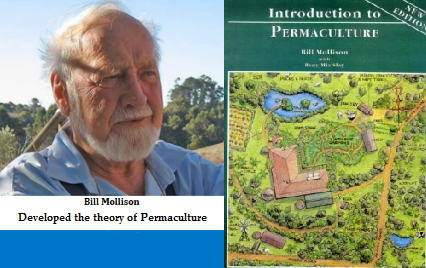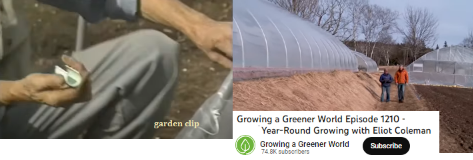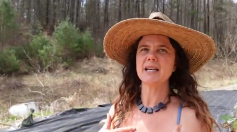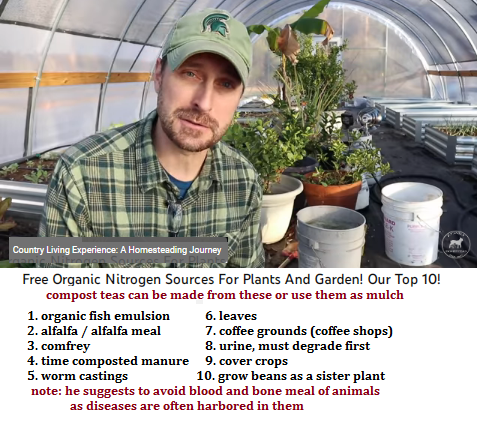|

video - A radio interview with Bill Mollison
He tells the history of his vision of Permaculture
From wikipedia:
Bruce Charles "Bill" Mollison (4 May 1928 – 24 September 2016) was an Australian researcher, author, scientist, teacher and biologist. In 1981, he was awarded the Right Livelihood Award "for developing and promoting the theory and practice of permaculture" or "permanent agriculture."
In 1954, at the age of 26, Mollison joined and worked for the 'Wildlife Survey Section' of the Commonwealth Scientific and Industrial Research Organisation (CSIRO). In the 1960s, he worked as a curator at the Tasmanian Museum. He also worked with the Inland Fisheries Commission, where he was able to resume his field work. In 1966, he entered the University of Tasmania. After he received his degree in bio-geography, he stayed on to lecture and teach, and developed the unit of Environmental Psychology.
As he states in this radio interview, his vision of environmental design
unrolled for him like a carpet rolling down a hill. He saw the whole of it.
He saw how a design could be formed that perfected the efficiency of life...
for the earth, for the animals, for humans, and for the sustaining and
the health of it all. All things have a place in this design... it is a matter of
giving everything thorough thought.
At the time of Mollison's vision, farming was largely done as a monoculture
system. Methods had been created to sterilize the soil, and so...
when the health of the soil was lost... the system had to create other
synthetic methods to repair the damage... poisons... chemicals.
It was a crazy cycle that had been promoted by "world planners"
(fools who play like kings and who have little shame) ... in the thinking
that that was how to feed the world. But... these monoculture farming
systems will turn entire regions into desert in the space of about 200 years.
Add to this damage... using chemically-treated water.
Permaculture is not just "organic" farming... it is a system of farming, and
animal pasturing, and the planting of perennials, bushes, and trees. It is
creating swales in hills to enable the retention of water, and to slow the
draining of water away from the fields and orchards. It is planting
orchards in layers so that all the growth will benefit its best from sun
and the interplay between each other. One bush will draw deep into soil
to retrieve minerals that another plant can then use.
Mollison said:
"After many years as a scientist with the CSIRO Wildlife Survey Section and with the Tasmanian Inland Fisheries Department, I began to protest against the political and industrial systems I saw were killing us and the world around us. But I soon decided that it was no good persisting with opposition that in the end achieved nothing. I withdrew from society for two years; I did not want to oppose anything ever again and waste time. I wanted to come back only with something very positive, something that would allow us all to exist without the wholesale collapse of biological systems."
In 1974–75, he and David Holmgren "jointly evolved a framework for a sustainable agricultural system based on a multi-crop of perennial trees, shrubs, herbs (vegetables and weeds), fungi, and root systems" for which they coined the word "permaculture".
Many modern homesteaders have studied these designs and various others
and have adapted them in practical ways to their own experiences in
small farming. There is much invention occurring as techniques are
applied and evolved in the real-life application of them. For instance,
pigs are used to clear overgrowth in thickets too thick for a farmer to access.
The pigs dig deep to get roots... and help eliminate nuisance growth. And
ranching cows uses a rotation of pastures that allows grass growth and the
break-down of manure in resting pasture.
Here are a few of these farmers... and their techniques.


video - Easy DIY Hoop PVC Greenhouse or Shadehouse
Easy DIY Hoop PVC Greenhouse or Shadehouse
SubTerra Organics
"Easy DIY PVC hoop greenhouse or shade house as we are using it. The installation was beyond quick and easy with the most labor in ground preparation for our needs. The entire build only requires 1 person to accomplish. The hoops can be covered with plastic if desired or we used shade cloth to house plant inventory."
products used:
Dewitt ground cover http://amzn.to/2h2BJuY
6" Ground staples http://amzn.to/2uwWC6o
1/4 x 80ft nylon rope for ridge support http://amzn.to/2h2uu6f
Auger Anchors to tie off rope http://amzn.to/2jS6AZj
Shade cloth http://amzn.to/2uBgjID

And that greenhouse build was inspired by this greenhouse build
video - Eliot Coleman greenhouse video
Coleman's show was "Growing Naturally"
Eliot gives good tips on starting plants, shows many examples of
heirloom tomatoes, and demonstrates the reasoning of DIY greenhouses
and how they work in the various growing zones. Very informative video.

video - Episode 1210 - Year-Round Growing with Eliot Coleman
Eliot, in Maine, discusses how he started by using cold frames
(which was a garden box with a glass window top)
then discovered a poly greenhouse over the cold frames
added twice as much protection from the cold. He now uses a
special fabric for his smaller hoop covers.
Each layer adds a USDA growing zone, temperature-wise,
or about 500 miles south... but depletes the sun 10%, so it is limited
to about 2 layers of cover... giving snowy Maine a zone comparable
to Georgia.

Channel where I found Eliot's video. Other good videos here.
video - Growing a Greener World videos

Aug 31, 2022 -
A tour of Wild Abundance with Natalie Bogwalker as she shares
her work to rapidly build soil using horse manure, straw, and occultation
(blocking sunlight to kill weeds).

video - Building Soil Quickly with Permaculture
When swales were cut into a steep hill to shape a more level planting
field, it removed the top soil and left just a layer of clay. Natalie began to
rebuild the soil with partially degraded wood chips, topped with spoiled
hay bales, topped with composted horse manure. All done very cheaply.
This combination turned into good soil 6 to 8 inches deep in one year.
Natalie is a homestead teacher.
Find out more about Natalie and her other work at:
https://www.wildabundance.net/

Nitrogen fertilizer from wood ash.

video - From The Ashes Comes Life Again - Wood Ashes
Homemade Fertilizer - Potassium / Calcium / Magnesium
Garden Like a Viking YouTube channel

video - Free Organic Nitrogen Sources For Plants And Garden! Our Top 10!

Why would anyone starve in this world?
Give people the seeds and the knowledge.
If the concerns were truly genuine about "climate change"
the geniuses who now claim to be saving us
in traumatic and sadistic ways...
would have given us the tools to manage a "transition."
Mass transportation... ?
Food distribution solutions... ?
Housing that needed little temperature control... ?
Solar-powered business standards...?
Now the money has been spent... on war... not life.
These self-appointed managers... are either idiots... or monsters.
|
|
